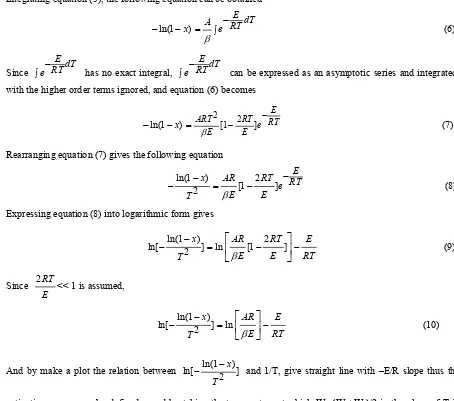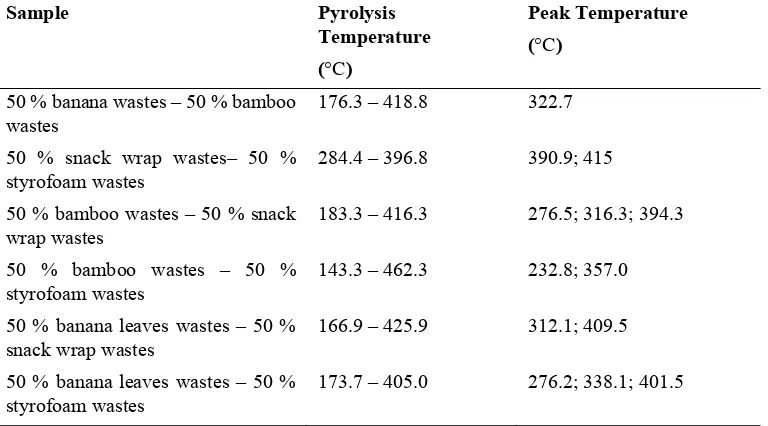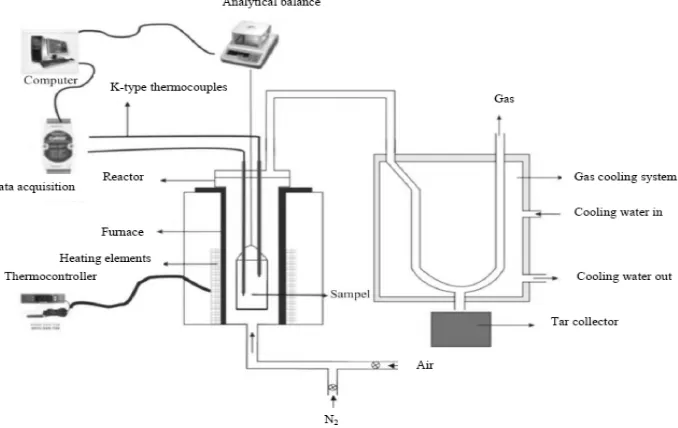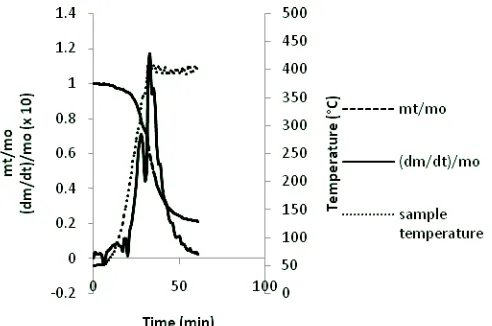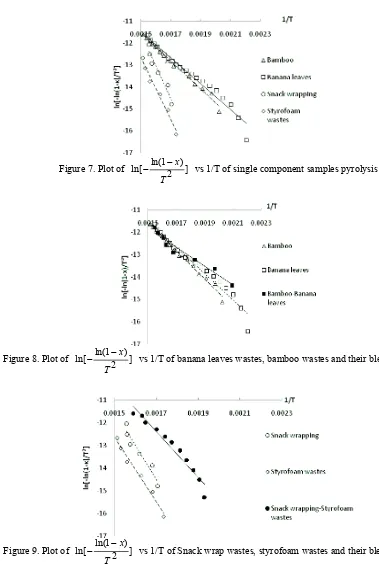Thermogravimetric Analysis and Global Kinetics of Segregated MSW
Pyrolysis
Dwi Aries Himawanto
Department of Mechanical Engineering, Sebelas Maret University
Jalan Ir. Sutami no. 36A, Kentingan, Surakarta, Republic of Indonesia
Ph.D student in Department of Mechanical and Industrial Engineering, Gadjah Mada University
Tel: 62-271-632163 E-mail: [email protected]
Indarto, Harwin Saptoadi & Tri Agung Rohmat
Department of Mechanical and Industrial Engineering, Gadjah Mada University
Jalan Grafika no. 2 Bulaksumur, Yogyakarta, Republic of Indonesia
Received: October 26, 2011 Accepted: November 28, 2011 Published: January 1, 2012
doi:10.5539/mas.v6n1p120 URL: http://dx.doi.org/10.5539/mas.v6n1p120
The research is financed by the Directorate General of Higher Education, Ministry of National Education RoI under Disertasion Research Grant in 2010 and Competitive Research Grant in 2009-2010 research program
Abstract
Municipal Solid Wastes (MSW) has great potential as a clean, renewable feedstock for producing modern energy carriers through thermochemical process, called pyrolysis. However, despite their enormous potential as energy sources, their thermal characteristics are still not well known. Moreover many researches just pay a little attention on MSW from developing countries, for example Indonesia MSW contains some indigenous wastes such as bamboo and banana leaves wastes, therefore this paper tries to show the slow pyrolysis characteristics of Indonesian MSW.
Investigations on behaviors of segregated MSW slow pyrolysis have been conducted using macro balance apparatus. Four components of segregated MSW (bamboo wastes, banana leaves wastes, snack wrap wastes and styrofoam wastes) and their blends were pyrolised and then thermogravimetry analysis has been done and their characteristics such as pyrolysis profiles and activation energies, were analysed and calculated. About 20 grams of samples were pyrolysed under 100 ml/min N2 at constant heating rate of 10 °C /min from room temperature to 400 °C final pyrolysis temperature and then the temperature of samples were kept constant for 30 minutes. The nitrogen flow serve swept gas which ensures an inert atmosphere during the pyrolysis test. In order to indentify pyrolysis characteristics of the samples, thermogravimetry analysis was performed. The recorded data were weight losses and sample temperatures during the pyrolisis process.
The results of the research showed that bamboo wastes and banana leaves wastes could be categorized as low stability organics, while snack wrap wastes could be categorized as polymer mixture materials and styrofoam wastes could be classified as plastic materials. Meanwhile profiles of blends materials pyrolysis followed the characteristics of their single components which is indicated by peak temperature. This study also found that global kinetic method could calculate the pyrolysis activation energy.
Keywords: MSW, Pyrolysis, Thermogravimetry, Global kinetics
1. Introduction
Slow pyrolysis of MSW can be a prospective technology to treat MSW if compared with other alternatives which can solve environmental and energy problems. Pyrolisis is defined as thermal degradation of solids in a limited oxygen condition that can produce permanent gas, pyrolitic liquid and char (Di Blasi, 2008). A research of the MSW pyrolisis using 12 kg MSW with a temperature range 400 °C – 650 °C for 4 hours could produce
52.2% tar, 25.2% char and 22.6% gas (Ojolo and Bamgboye, 2005). A study about segregated MSW slow pyrolisis in a packed bed pyrolizer showed that packed bed pyrolisis system could increase char production 30% - 100% compared with the TGA processes (Swithenbank, et al., 2005). A research which carbonized MSW as an artificial coal showed that the heating value of MSW char could reach a half of coal heating value (Matsuzawa, et al., 2007). An optimum slow pyrolysis condition which could produce the balance pyrolisis product was conducted by Phan et al. (2008) and found the optimum pyrolysis temperature should be below 500 °C.
Grammelis et al. (2009) conducted a reserach about pyrolysis kinetics and combustion characteristics of waste recovered fuels, and found that the thermal degradation of the refuse derived fuel samples was modeled assuming four parallel reactions corresponding to the devolatilisation of cellulose, hemicellulose, lignin and plastics.
Moreover many researches pay only a little attention on MSW from developing countries, for example Indonesia MSW contains some indigenous wastes such as bamboo and banana leaves wastes, therefore this paper tries to show the slow pyrolysis characteristics of Indonesian MSW.
2. Materials and Methods
2.1 Samples
Materials tested in this research were unprocessed MSW components which were taken from Final Waste Diposal Site Piyungan Yogyakarta, and consist of organic wastes and unorganic wastes, which could be seen on Figure 1.
The organic wastes consists of bamboo wastes (from Javanese traditional basket) and banana leaves wastes (from Javanese traditional food wrap). These wastes come from Indonesian traditional market. The anorganic wastes, especially plastic based wastes, consists of snack wrap wastes and styrofoam wastes. All of samples were crushed until the particles sizes of samples passed 20 mesh.
2.2 Methods
Pyrolysis was carried out with macro balance which was adopted from Swithenbank et al. (2005). About 20 grams of sample was pyrolysed under 100 ml/min N2 at constant heating rate of 10 °C /min from room temperature to 400 °C final pyrolysis temperature which is kept constant for 30 minutes. The nitrogen flow serve swept gas which ensures an inert atmosphere during the pyrolysis test.
In order to indentify pyrolysis characteristics of the samples, thermogravimetry analysis was performed. The recorded datas were weight losses and sample temperatures during the pyrolisis process. A K-type thermocouple was inserted into the sample which located 2 cm from the center of sample basket and 1 cm above the base of sample basket. The sample temperatures were recorded with ADAM 4018 data acquisitions system, while the weight losses recorded with A&D GF-300 Digital Scale. The scheme of experimental apparatus is described in Figure 2.
3. Results and Discusion
3.1 Single Component Pyrolysis
wastes were laminated materials which consisted of several materials and one of those material had the lower peak temperature than polypropylene. Styrofoam wastes pyrolisis had two peak temperatures, i.e. 370.6 °C and 407.5 °C which could be categorised as plastic materials which have high thermal stability and have peak temperature above of 400 °C. The styrofoam wastes pyrolysis which is used in this research followed the thermal decomposition of GS and polystyrene, which have peak temperature 394 °C and 467 °C. GS is the real plastic wastes from Germany and the exact composition is unknown (Heikkinen, et al., 2004).
3.2 Pyrolysis of Blends Materials
Table 2 shows the pyrolysis temperature ranges and the peak temperature of mixed components samples. It coud be seen that the mixed component samples initial pyrolysis temperature located between the initial pyrolysis temperature of each component with exception in organic mixed component.
The initial pyrolysis temperature of organic mixed component higher than the single component pyrolysis initial temperature. It caused of synergethic reactions which occured between the component.
Banana wastes – bamboo wastes mixed samples begin to decompose at 176.3 °C and finished at 418.8 °C and signed with one maximum mass loss rate at 322.7 °C and one shoulder located at 273.4 °C. According to Di Blasi (2008) biomass started to be decomped at 227 °C, while Kalita et al. (2009) found that bamboo dust pyrolysed at 190 °C to 365 °C. Shoulder which located at left side of maximum loss rate temperature indicated that the sample was lignocellusic material which maximum mass loss rate just occured at one sample while the other sample would be signed with litle peak (shoulder). Snack wrapping – styrofoam mixed wastes pyrolysis occured at 284.4 °C – 396.8 °C with two maximum mass losses temperature.
Meanwhile for the unorganic-organic blends gave the same results i.e there were some peak which represented their main component as seen in Figure 3 –Figure 6. From those figures, could be seen that bamboo wastes – snack wrap wastes mixtures started pyrolise at 183.3 °C and continuing until 416.3°C with three peak temperatures which occured at 276.5 °C, 316.3 °C and 394.3 °C. The first peak temperature refered to bamboo peak temperature, the third peak temperature near to the snack wrap temperature, while the second peak temperature occured as the effect of synergethic reactions between the components. The phenomena could be seen in banana wastes – snack wrap wastes mixtures.
A different phenomena could be seen in the styrofoam based mixtures pyrolysis. It could be observed that the first peak temperature, which represented biomass component temperature, were lower than its component peak temperatures. These conditions predicted caused of the styrofoam physical characterstics i.e melt and hardened while pyrolised.
3.3 Global Kinetic Analysis
Energy activation is calculated based on Arrhenius formulae with first reaction order, which called global kinetics, and expressed as the following formulae
(1 )
Integrating equation (5), the following equation can be obtained
can be expressed as an asymptotic series and integrated, with the higher order terms ignored, and equation (6) becomes
Rearranging equation (7) gives the following equation
ln(1 ) [1 2 ] the intercept term of Eq. (10), the pre-exponential factor A can also be determined.
Figure 7 – Figure 13 displayed the plot between ln[ ln(1 )] 2
x
T
and 1/T for the samples both singles and mixed,
and the results of all samples summarized in Tables 3.
The results showed that bamboo pyrolysis activation energy is 52.598 kJ/mol, the previous study about bamboo dust pyrolysis had been done by Kalita et al. (2009) and found that the pyrolysis activation energy was 98.22 kJ/mol with reaction order 3.55 at temperature range 190 °C – 365 °C. Meanwhile PS and LDPE had activation energy were 251.2 kJ/mol and 206.4 kJ/mol (SØrum (2001)), while the activation energy of styrofoam wastes and snack wrap wastes which found from this study were 118.208 kJ/mol and 124.186 kJ/mol. From this study also found the pyrolysis activation energy of banana leaves was 49.063 kJ/mol.
For biomass based materials, the pyrolysis activation energy influenced by thermal decomposition process of their main component i.e hemicelulose, lignin and cellulose. Hemicelulose decomposed at tamperature range 225 °C – 325 °C with activation energy varied between 80 – 116 kJ/mol, lignin pyrolysed at 325 °C – 375 °C and have higher activation energy 195 – 286 kJ/mol, while cellulose thermally decomposed gradually at 250 °C – 500 °C and had the lowest activation energy 18 – 65 kJ/mol (Di Blasi, 2008).
occured at the lower activation energy than their components. These phenomenon is predicted caused by the efect of styrofoam component which have nearly 100% of volatile matter. The greater volatile components in styrofoam wastes make the pyrolysis process could done with lower activation energy, these occured in styrofoam wastes based blends.
On the contrary, the snack wrap wastes based blends need a higher activation energy if it is compared their lignocellulosic component and if compared with styrofoam based blend pyrolysis, these different behaviour can be explained by the fact that polypropylene soften at about 440 °C (Cai, et al., 2008) which could be inhibit the volatile matter evolution of lignocellulosic component so that to increase the activation energy.
4. Conclusions
The results of this research showed that the organic components wastes could be catogorized as low stability organics, while the snack wrapping could be categorised as mixed polymer material. Styrofoam wastes could be categorised as plastic material which have high thermal stablity. This study also found that global kinetic method could to calculate the pyrolysis activation energy. The lignocellulosic blends pyrolysis gave the lower activation energy if compared with their component. Anorganic wastes blends pyrolysis also occured at the lower activation energy than their components. On the contrary, the snack wrap wastes based blends need the higher activation energy if compared their lignocellulosic component and if compared with styrofoam based blend pyrolysis.
References
Cai, J., Wang, Y., Zhou, L., & Huang, Q. (2008). Thermogravimetric Analysis and Kinetic of Coal/Plastic Blends during Co-Pyrolisis in Nitrogen Atmosphere. Fuel Processing Technology, 89, 21-27. http://dx.doi.org/10.1016/j.fuproc.2007.06.006
Di-Blasi, C. (2008). Modeling Chemical and Physical Processes of Wood and Biomass Pyrolisis. Progress in Energy and Combustion Science, 34, 47-99. http://dx.doi.org/10.1016/j.pecs.2006.12.001
Grammelis, P., Basinas, P., Malliopoulou, A., & Sakellaropoulos, G. (2009). Pyrolisis Kinetics and Combustion Characteristics of Waste Recovered Fuels. Fuel, 88, 195-205. http://dx.doi.org/10.1016/j.fuel.2008.02.002
Heikkinen, J. M., Hordijk, J. C., de Jong, W., Spliethoff, H.(2004). Thermogravimetry as a tool to clasify waste components to be used for energy generation. J.Anal.Appl.Pyrolysis, 71, 883-900. http://dx.doi.org/10.1016/j.jaap.2003.12.001
Himawanto, D. A., Indarto, Saptoadi, H., & Rohmat,T. A.(2011). Characteristics and Global Kinetics Approaches of Segregated MSW Slow Pyrolysis (in Indonesian languange). Jurnal Reaktor, 13(3), 140-147. Kalita, P., Mohan, G., Pradeep, K., & Mahanta, P. (2009). Determination and Comparasion of Kinetic Parameter of Low Density Biomass Fuels. Journals of Renewable and Sustainable Energy, 1, 023109. http://dx.doi.org/10.1063/1.3126936
Matsuzawa, Y., Mae, K., Hasegawa, I., Suzuki, K., Fujiyoshi, H., Ito, M., & Ayabe, M. (2007). Characterization of Carbonized Municipal Waste as Substitute for Coal Fuel. Fuel, 86, 264–272. http://dx.doi.org/10.1016/j.fuel.2006.06.008
Ojolo, S. J., & Bamgboye, A. I. (2005).Thermochemical Conversion of Municipal Solid Waste to Produce Fuel and Reduce Waste. Agicultural Engineering International: the CIGR Ejournal, Vol. VII, Manuscript EE 05 006. Phan, A. N., Ryu, C., Sharifi, V. N., & Swithenbank, J. (2008). Characterisation of Slow Pyrolisis Products from Segregated Wastes for Energy Production. J.Anal.Appl.Pyrolisis, 81, 65-71. http://dx.doi.org/10.1016/j.jaap.2007.09.001
SØrum, L. (2001). Characteristics of MSW for Combustion System, Technical Report, SINTEF Energy Research.
Swithenbank, J., Sharifi, V. N., & Ryu, C. (2005).Waste Pyrolisis and Generation of Storable Fuel. SUWIC Department of Chemical and Process Engineering, The University of Sheffield.
Table 1. Singles component samples pyrolysis temperature ranges
Styrofoam wastes 316.3 - 417 370.6; 407.5
Table 2. Mixed samples pyrolysis temperature ranges
Sample Pyrolysis
Table 3. Summary of kinetic parameters for samples pyrolysis
Samples E
Snack wrapping wastes 124.186 8.36 x 107 0.9292
Styrofoam wastes 118.208 8.37 x 107 0.9776
(a) (b) (c) (d) Figure 1. Materials
(a) Bamboo wastes; (b) Banana leaves wastes; (c) Snack wrap wastes; (d) Styrofoam wastes
Figure 2. Experimental apparatus schematic
Figure 4. Bamboo – styrofoam wastes pyrolysis characteristics
Figure 5. Banana leaves – snack wrap wastes pyrolysis characteristics
Figure 7. Plot of ln[ ln(12x)] T
vs 1/T of single component samples pyrolysis
Figure 8. Plot of ln[ ln(1 )] 2
x
T
vs 1/T of banana leaves wastes, bamboo wastes and their blends pyrolysis
Figure 9. Plot of ln[ ln(1 )] 2
x
T
Figure 10. Plot of ln[ ln(1 )] 2
x
T
vs 1/T of bamboo wastes, snack wrap wastes and their blends pyrolysis
Figure 11. Plot of ln[ ln(12x)] T
vs 1/T of banana leaves wastes, snack wrap wastes and their blends pyrolysis
Figure 12. Plot of ln[ ln(1 )] 2
x
T
Figure 13. Plot of ln[ ln(1 )] 2
x
T
vs 1/T of Banana leaves wastes, styrofoam wastes and their blends pyrolysis
